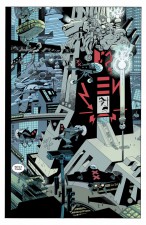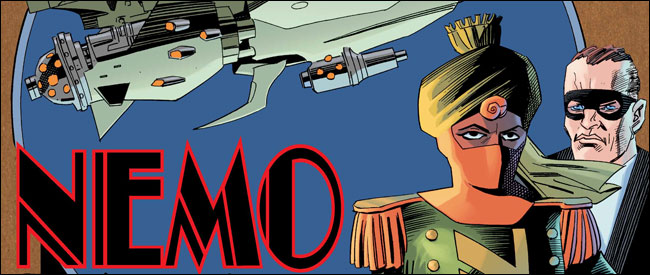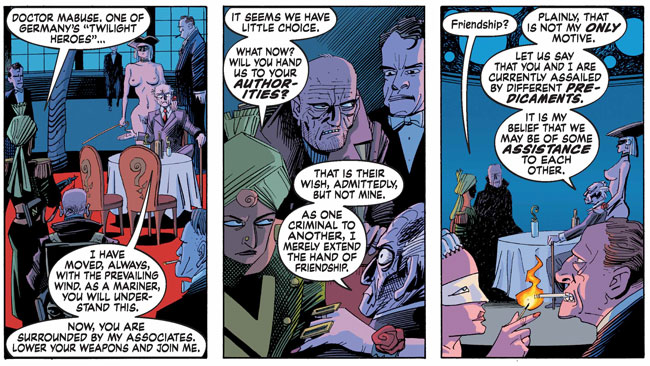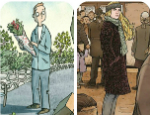After the richness of its League of Extraordinary Gentlemen antecedents, Alan Moore and Kevin O’Neill’s brief dip into the world of German expressionism comes as a disappointment.
One of Alan Moore’s lesser-known works popped up in the final issue of Marvel’s Heavy Metal-wannabe anthology Epic Illustrated (#34, February 1986). A futuristic eight-pager with artist Rick Veitch on the danger of alien STDs, its title – drawn from the punch line of a bleak joke – was perhaps a premonition of how the prevailing winds of comics fandom would eventually turn against the one-time Greatest Living Englishman: ‘Love Doesn’t Last Forever’.
Once upon a time, new Moore material would have been among the most eagerly awaited highlights of the comics year. Things change. A couple of months ago the reprint of The Bojeffries Saga (with Steve Parkhouse) – complete with a brand new 24-page story – slipped into the world largely unheralded, and now Nemo: The Roses of Berlin – the latest instalment in Moore and Kevin O’Neill’s epic League of Extraordinary Gentlemen canon – seems unlikely to be setting the shelves alight.
However, even though he’s become something of an Unperson in the withering gaze of social media, Alan Moore remains a noteworthy presence – which makes it all the more disappointing for those of us who’d still like to champion his work that this is probably the weakest entry in the series so far.
Following on 16 years after the events of the first Nemo volume, Heart of Ice, this is another slender but beautifully produced hardback. It picks up Janni Dakkar/Nemo, the pirate queen of Lincoln Island and captain of the Nautilus, in the chaotic days of the Second World War – a war that, in the LOEGverse, is being fought against Adenoid Hynkel, the Hitler analogue created by Charlie Chaplin in his 1940 film The Great Dictator.
When her daughter Hira and son-in-law Robur are shot down and captured by German/Tomanian forces, Janni and her consort, Broad-Arrow Jack, head to the heart of the darkness – a vision of Berlin hewn from the world of German expressionist cinema in general and Fritz Lang’s Metropolis in particular.
Once there, they encounter members of the ‘Twilight Heroes’ – the Teutonic counterparts of the LOEG – and find themselves drawn into a whole new web of intrigue that culminates in a final showdown with an old adversary.
 There’s no doubt that any new book from Moore and O’Neill is worth a closer look. However, at just 56 pages, The Roses of Berlin feels like a bit of an amuse-bouche between the main courses, despite the potential offered by the environment and source material.
There’s no doubt that any new book from Moore and O’Neill is worth a closer look. However, at just 56 pages, The Roses of Berlin feels like a bit of an amuse-bouche between the main courses, despite the potential offered by the environment and source material.
Intertextuality is at the heart of the LOEG experience, but in contrast to the cosmic horror evoked in Heart of Ice (especially in the celebrated temporal distortion sequence), The Roses of Berlin never quite achieves the distorted, paranoid atmosphere of the German expressionist cinema it draws on. Instead, a few characters and visuals are chosen as the set-dressing for a fairly generic series of action scenes and chases.
Kevin O’Neill gets his money-shot spreads, replete with unearthly gadgetry and architecture, but it never articulates the unease of its source material, which was the specific product of Germany’s trauma during World War One and the grim reality of life in the Weimar republic.
Another problem with the book is its protagonist. Janni Nemo is consistently and believably delineated, but she just isn’t as compelling as the leads in the previous iterations of the LOEG. We can understand how her experiences and background would have left her so hard-bitten, but she lacks the wit and readability that Mina Harker brought to the book from the first scene of the first issue.
The Century trilogy had its flaws, but it was driven by the barbed interplay and shifting relationship between Mina, Allan Quartermain and Orlando. While there’s no doubting the depth of Janni’s bond with Jack, her joyless intractability makes her a much harder – and, ultimately, less rewarding – read.
Finally, and most surprising of all, there are even a few moments when the narrative either isn’t clear or relies on a bit of coincidence. And while the extensive use of the German language might add authenticity, it carries a lot more information than the foreign language sections in earlier books (which, in scenes like Janni’s conversation with her father on his death-bed, were largely legible through the expressions and body language of the characters).
I’m all for comics that make readers work a little to get to their treats, and I know not everyone is a fan of the usual <translation conventions>, but to stick so much important information in a language that will be unreadable in the first instance to most of the likely audience smacks a bit of truculence.
When the book was announced, I was initially worried that we might face a series of Cabaret-style musical numbers (harking back to the jarring Threepenny Opera bits of Century: 1910). We didn’t get that, but sadly what we did get – a functional skate across the surface of German expressionism – didn’t sing off the page either.
Alan Moore (W), Kevin O’Neill (A) • Top Shelf Productions/Knockabout, $14.95

















